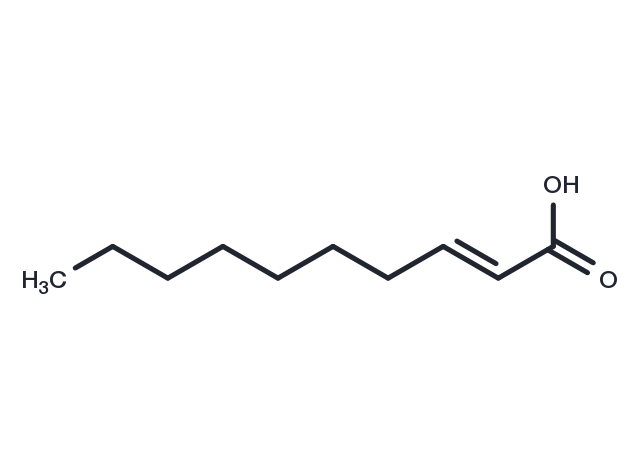Powder: -20°C for 3 years | In solvent: -80°C for 1 year


(E)-2-Decenoic acid (trans-2-Decenoic acid) is an unsaturated fatty acid found in royal jelly produced from the hypopharyngeal and mandibular gland secretions of honeybees.

| Pack Size | Availability | Price/USD | Quantity |
|---|---|---|---|
| 10 mg | In stock | $ 33.00 | |
| 25 mg | In stock | $ 50.00 | |
| 50 mg | In stock | $ 67.00 | |
| 100 mg | In stock | $ 96.00 | |
| 1 mL * 10 mM (in DMSO) | In stock | $ 50.00 |


| Description | (E)-2-Decenoic acid (trans-2-Decenoic acid) is an unsaturated fatty acid found in royal jelly produced from the hypopharyngeal and mandibular gland secretions of honeybees. |
| In vitro | Trans-2-decenoic acid does not inhibit AI-2-specific signaling, but rather the luciferase reaction used for its detection. A potential biological role of trans-2-decenoic acid was then discovered. It is able to suppress the transition from yeast to hyphal morphology in the opportunistic human pathogen Candida albicans at concentrations that do not affect growth. The expression of HWP1, a hyphal-specific signature gene of C. albicans, is abolished by trans-2-decenoic acid. trans-2-Decenoic acid is structurally similar to the diffusible signal factor (DSF) family of interkingdom-signaling molecules and is the first member of this family from a Gram-positive organism (Streptococcus DSF, SDSF). SDSF activity was also found in S. mitis, S. oralis, and S. sanguinis, but not in other oral bacteria. SDSF could be relevant in shaping multispecies Candida bacteria biofilms in the human body[1]. |
| Synonyms | trans-2-Decenoic acid |
| Molecular Weight | 170.25 |
| Formula | C10H18O2 |
| CAS No. | 334-49-6 |
Powder: -20°C for 3 years | In solvent: -80°C for 1 year
DMSO: 100 mg/mL (587.37 mM)
You can also refer to dose conversion for different animals. More
bottom
Please see Inhibitor Handling Instructions for more frequently ask questions. Topics include: how to prepare stock solutions, how to store products, and cautions on cell-based assays & animal experiments, etc.
(E)-2-Decenoic acid 334-49-6 Others inhibit Inhibitor trans-2-Decenoic acid (E)2Decenoic acid 2-Decenoic acid (E) 2 Decenoic acid inhibitor
